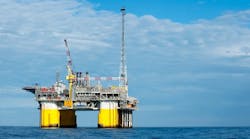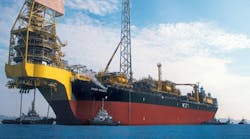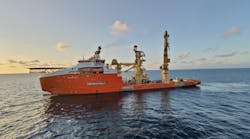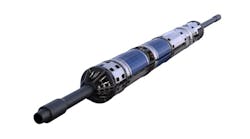A concept of installing seawater treatment on the seabed was presented recently, using as an example, an installation taking place in a water depth of 1,640 ft. Some advantages claimed for such a system included the following:
- Delivered water quality is as good as or better than that delivered by conventional means
- Performance reliability is high
- Field life costs are similar to conventional systems
- A savings in cost can be achieved (in this example, it was 44%).
With the current emphasis being to minimize topside weight on offshore structures and to develop fields in greater water depths, any potential for topsides weight reduction needs serious consideration. The proposed technology locates the entire seawater treatment facility on the seabed, with 2-stage solids removal, disinfection, and pressure boosting prior to injecting the seawater.
The first stage of solids removal separates in excess of 99% of sand and other coarse particles larger than 22 microns, while the second stage removes neutrally buoyant particles larger than 200 microns. The seawater is chlorinated and injected via multi-stage centrifugal pumps, whose output is controlled by varying its speed or by a bypass return loop.
While the new technology will offer significant weight savings to operators, there are a number of areas of uncertainty that need to be investigated and clarified before the proposed technology can find universal acceptance. These include the following:
- Particle removal requirements for individual reservoirs
- Ensuring that final seawater quality is equal to, or better than, that achieved by conventional treatment systems
- Injection of aerated seawater
- Injection of low temperature water into low temperature reservoirs
- Injection of organic matter and its potential as a bacterial nutrient
- Sub-surface chemical incompatibility
- Increased solids ingestion during storm conditions
- Pump design to allow the handling of sand particles
TREATED SEAWATER QUALITY: The level of treatment of the seawater is dictated by the nature of the formation. No single filtration specification can meet all field requirements. For certain fields, operators take all measures necessary to inject at pressures below the fracture pressure, while other fields can inject coarse filtered seawater.
The suspended solids content of the untreated seawater is often a main driver in the decision whether or not to fine-filter the seawater. Regarding the final quality achievable, there are many different viewpoints on this. Some operators still adhere to fine filtration and stringent water quality monitoring to treat their water prior to injection.
INJECTION OF AERATED SEAWATER: If aerated seawater were injected, corrosion of carbon steel tubulars would occur. Resulting corrosion products would increase the solids loading leading to potential wellbore problems. Use of higher grade steels would resolve this problem, but at a significant cost penalty. The presenters in the example referred to above did not mention the inclusion of high-grade steel tubulars and well components in their comparison, but hopefully these were rolled into their costings.
The effect of introducing aerated seawater into the reservoir fluids has been under debate for some considerable time with, as yet, no firm conclusions as to whether or not this will lead to subsurface problems.
LOW-TEMPERATURE RESERVOIR INJECTION: Where low temperature (<180°F) reservoirs are injected with cold (<60°F) seawater, the potential for generating thermal microfractures to disperse the suspended solids is unlikely.
ORGANIC MATTER INJECTION/BIOLOGICAL CONTROL: Injected organic matter could provide a nutrient source of carbon for bacteria. The use of chlorine for disinfection/bacterial control will only provide a good degree of control local to the dosing point. It has a limited persistence and will not provide full protection against bacterial growth in the reservoir itself.
SEAWATER/FORMATION WATER COMPATIBILITY: Where these waters are chemically incompatible, the provision of some means of adding a chemical scale inhibitor needs to be included. Since the possibility of adding chlorine from the host facility via the umbilical exists, presumably this could be adapted to carry other treatment chemicals.
SEABED TURBULENCE EFFECT: In shallower waters, surface storms have been known to lead to seabed turbulence, which has adversely affected the quality of seawater ingested by normal mid-depth seawater caissons. This could radically increase the solids loading on the seabed treatment system and should be allowed for in any shallow water system design. The design must cater for the potential for generating a sand pile on the seabed immediately below the water intake.
INJECTION PUMP DESIGN: One major problem for injection pump design is the presence of solids in the water and the increased levels of erosion these solids generate. The pump design needs to take the level and type of solids into account.
Provided the problems outlined above can be addressed without adversely affecting the overall economics of the system, there is real potential for the seabed injection system to become a serious technology in future field developments.
David Robinson
ALTRA Consultants Limited
Aberdeen, Scotland




